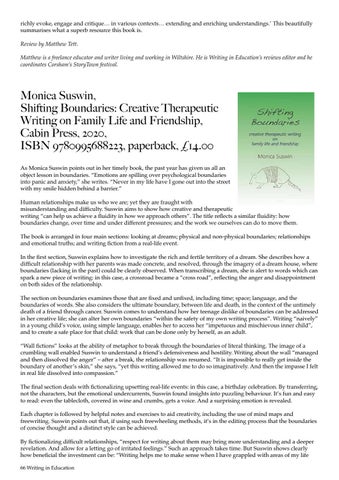richly evoke, engage and critique… in various contexts… extending and enriching understandings.’ This beautifully summarises what a superb resource this book is. Review by Matthew Tett. Matthew is a freelance educator and writer living and working in Wiltshire. He is Writing in Education’s reviews editor and he coordinates Corsham’s StoryTown festival.
Monica Suswin, Shifting Boundaries: Creative Therapeutic Writing on Family Life and Friendship, Cabin Press, 2020, ISBN 9780995688223, paperback, £14.00 As Monica Suswin points out in her timely book, the past year has given us all an object lesson in boundaries. “Emotions are spilling over psychological boundaries into panic and anxiety,” she writes. “Never in my life have I gone out into the street with my smile hidden behind a barrier.” Human relationships make us who we are; yet they are fraught with misunderstanding and difficulty. Suswin aims to show how creative and therapeutic writing “can help us achieve a fluidity in how we approach others”. The title reflects a similar fluidity: how boundaries change, over time and under different pressures; and the work we ourselves can do to move them. The book is arranged in four main sections: looking at dreams; physical and non-physical boundaries; relationships and emotional truths; and writing fiction from a real-life event. In the first section, Suswin explains how to investigate the rich and fertile territory of a dream. She describes how a difficult relationship with her parents was made concrete, and resolved, through the imagery of a dream house, where boundaries (lacking in the past) could be clearly observed. When transcribing a dream, she is alert to words which can spark a new piece of writing: in this case, a crossroad became a “cross road”, reflecting the anger and disappointment on both sides of the relationship. The section on boundaries examines those that are fixed and unfixed, including time; space; language, and the boundaries of words. She also considers the ultimate boundary, between life and death, in the context of the untimely death of a friend through cancer. Suswin comes to understand how her teenage dislike of boundaries can be addressed in her creative life; she can alter her own boundaries “within the safety of my own writing process”. Writing “naively” in a young child’s voice, using simple language, enables her to access her “impetuous and mischievous inner child”, and to create a safe place for that child: work that can be done only by herself, as an adult. “Wall fictions” looks at the ability of metaphor to break through the boundaries of literal thinking. The image of a crumbling wall enabled Suswin to understand a friend’s defensiveness and hostility. Writing about the wall “managed and then dissolved the anger” – after a break, the relationship was resumed. “It is impossible to really get inside the boundary of another’s skin,” she says, “yet this writing allowed me to do so imaginatively. And then the impasse I felt in real life dissolved into compassion.” The final section deals with fictionalizing upsetting real-life events: in this case, a birthday celebration. By transferring, not the characters, but the emotional undercurrents, Suswin found insights into puzzling behaviour. It’s fun and easy to read: even the tablecloth, covered in wine and crumbs, gets a voice. And a surprising emotion is revealed. Each chapter is followed by helpful notes and exercises to aid creativity, including the use of mind maps and freewriting. Suswin points out that, if using such freewheeling methods, it’s in the editing process that the boundaries of concise thought and a distinct style can be achieved. By fictionalizing difficult relationships, “respect for writing about them may bring more understanding and a deeper revelation. And allow for a letting go of irritated feelings.” Such an approach takes time. But Suswin shows clearly how beneficial the investment can be: “Writing helps me to make sense when I have grappled with areas of my life 66 Writing in Education






